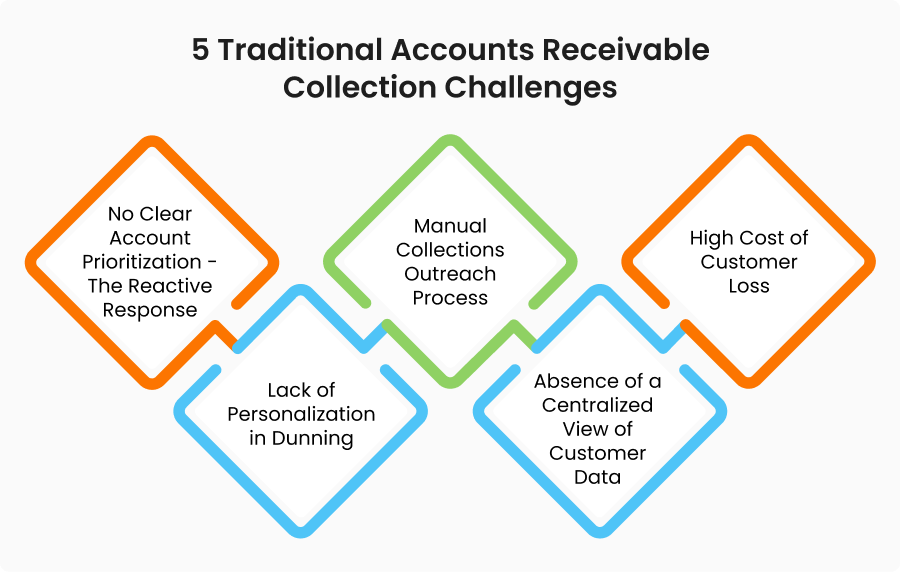Key Takeaways
- Explore the systematic 8-step collections process to ensure overdue invoices get paid.
- Gain insights into the 5 common challenges in traditional accounts receivable collections.
- Uncover 5 strategies to enhance your accounts receivable collections and KPIs to track.

Introduction
Cash flow problems often lead to significant stress for businesses, and they often stem from receiving invoice payments after the due date. If you’re grappling with past-due invoices, you’re not alone – a staggering 87% of businesses face this challenge. So, what’s the solution?
Being proactive and taking targeted actions are essential for efficiently recovering late invoices. At HighRadius, we’ve observed that more than 30% of outstanding invoices require three or more payment reminders before resolution. This highlights the critical role of a robust accounts receivable collections process.
In this practical guide, we’ll walk you through the accounts receivable collections process, outlining the comprehensive steps and key performance indicators vital for ensuring successful collections procedures. To ease the implementation process, we will also be sharing complimentary collections templates, setting you firmly on the path to optimized accounts receivable management.
Let’s get right into what works.
Understanding Accounts Receivable Collections
What is Accounts Receivable Collections?
Accounts receivable collections refer to the systematic process of recovering the amounts owed to a company by its customers after goods or services have been delivered but not yet paid for. It’s a crucial financial activity that ensures the liquidity and financial health of a business.
Why is the Accounts Receivable Collection Process Important?
The account receivable collection process is a cornerstone for maintaining a robust and healthy cash flow. It’s more than just a financial activity; it’s an operational necessity that plays a pivotal role in a company’s receivables process and cash flow growth. Let’s delve into why it holds such paramount importance:
1. Ensures Steady Cash Flow
The collection process is instrumental in improving cash flow by ensuring that funds owed to the company are collected in a timely manner. Most companies aim to complete their accounts receivable collections within a 30 to 90-day window, ensuring the timely availability of funds for seamless operations.
2. Facilitates Debt Payment
Timely collection from customers empowers companies to settle their debts, further bolstering their financial standing. The money, although accounted for, bolsters the operational activity only upon successful collection, underlining the significance of a streamlined collection process.
3. Accounting and Reporting
Accounts receivable collections are meticulously recorded on the balance sheet, offering a clear picture of the company’s financial health. While an accounts receivable is recorded as an asset, its successful collection symbolizes the actual influx of cash, reinforcing the company’s liquidity position.
4. Revenue Recognition
The collections process flow contributes substantially to revenue enhancement by ensuring the influx of owed money from existing customers. This process ensures financial growth and stability by minimizing unpaid debts and optimizing cash flow, thereby solidifying the company’s financial foundation.
In essence, understanding and effectively managing the accounts receivable collection process is not just a financial necessity but a strategic imperative for ensuring business continuity, growth, and profitability. It’s about striking the right balance between maintaining positive customer relationships and ensuring the financial health of your business, making it a critical aspect of overall business management.
The 8 Key Steps in the Collection Process
To ensure that overdue invoices get paid, you need an effective collection process. You can use the steps outlined below to create one for your business.
Step 1: Aging Report Creation
From the moment the invoice is sent, monitor the payment status vigilantly. This early scrutiny aids in identifying potential delays, allowing for timely intervention.
Generate an aging report to categorize receivables based on their due date, streamlining the collection process and helping prioritize efforts.
Organize accounts into typical groupings: 0-30 days, 31-60 days, 61-90 days, and more than 90 days.
With a 60% lesser chance of getting paid after the 90-day overdue threshold, prioritize your attention on these “at-risk” invoices to maximize the likelihood of collection.
After the crucial step of aging report creation, it’s essential to delve into the stages of past-due recovery. These stages refer to time-based milestones and a consistent follow-up cadence that unfolds after a missed payment. Different companies define these phases uniquely, tailoring them to their specific payment cycles.
A typical model of past-due recovery stages would look something like this:
Step 2: Days 1-3 Past Due
Confirm the invoice was sent, ensure no disputes, and send an automated email reminder including an account statement.
Recognize that customers might be unaware of their overdue status or may require a minor repayment extension. Be flexible and understanding in your approach, viewing your brand as a partner offering practical solutions during early-stage collections.
In most scenarios, you will receive a response indicating that your payment is in process or obtain an explanation from your customer. This initial notice also serves as an opportunity to unearth any potential underlying disputes that might be brewing.
Step 3: Days 4-7 Past Due
Contact the customer by phone and/or email attempting to secure payment. Ensure any discrepancies or disputes have been resolved. Be prepared and specific when you make the phone call, having all necessary invoice details readily available, such as:
- Copy of the invoice
- Outstanding balance amount and
- Invoice number
- List of unpaid invoices
- Days past due
- Due payments amount
- Payment methods available
Step 4: Days 8-14 Past Due
Send a second automated email and follow up with a professional, scripted phone call. Notify the sales representative that payment is now one week late. Consider offering a payment plan for customers facing financial difficulties, as collecting some debt is better than none.
After your call, make sure you quickly follow up with an email – keeping track of your conversation in writing is key.
Step 5: Days 15-30 Past Due
Send a third automated email stating the account will incur late fees after 30 days. Follow up with a phone call to confirm receipt and remind the customer of late fees. Personalize your past-due notice to increase the chance of getting a response.
Your approach from here on will depend on your existing relationship with the customer. If deemed necessary, send warnings about potential interruptions of service unless the overdue payments are settled.
Be prepared to enforce late fees or halt new orders until the outstanding balance is cleared. These measures, while stern, are about striking a balance – enforcing payment while maintaining the integrity and positivity of the customer relationship.
Your approach should be firm yet respectful, clear yet considerate, ensuring the customer is motivated to settle the dues at the earliest, thereby safeguarding your business’s financial stability.
Step 6: Days 31-45 Past Due
Mail a letter on company letterhead stating payment is now 30 days late. Apply late fees to the account.
Step 7: Days 46-60 Past Due
It’s time to intensify your collection efforts. Begin by consistently calling and emailing the customer every 3-5 business days. Place the account on credit hold and notify the sales representative and customer of the credit hold.
While it’s essential to escalate your efforts and adopt a firmer tone, it’s equally crucial to maintain professionalism and respect in all communications.
It might be frustrating that the payment is significantly delayed despite your multiple friendly reminders, but preserving the customer relationship should remain a priority.
Express your concerns and expectations clearly and respectfully. Make the customer aware that the continued delay in payment is not standard practice and is adversely affecting the business relationship. However, ensure your communication is devoid of hostility or disrespect.
Step 8: Days 61-90 Past Due
When an account reaches 61-90 days past due, it’s time for significant measures. Notify senior management about the delinquent account and prepare to engage a collections agency, seek legal counsel, or write off the account as bad debt. This step is crucial in the collection process steps as it involves higher-level decision-making and external entities.
Be aware of the high cost associated with write-offs. With a 20% gross margin, your business would need to make five times the sales to balance out the loss. This financial strain highlights the importance of exhausting all possible avenues for collection before considering a write-off.
At this juncture, it’s beneficial to involve your sales or account management team actively. Given their direct relationship with the customer, their intervention can potentially unblock the impasse and facilitate payment. Their insights into the customer’s situation and concerns can also inform the next steps in the collection process, ensuring they are tailored to achieve the best possible outcome.
Even in the face of the potential for write-offs, prioritize clear, respectful communication and collaborative problem-solving. This approach not only enhances the likelihood of payment but also preserves the valuable customer relationship for future business interactions.
5 Challenges in Traditional Accounts Receivable Collections
Navigating the traditional account receivable collections landscape is a complex task, filled with obstacles that can impede the efficiency of the collection process and erode customer relationships. To make the process smoother it is crucial to be aware of the challenges that businesses often encounter in it – here are five such challenges.

1. No Clear Account Prioritization – The Reactive Response
In the traditional collection process, actions are typically reactionary, triggered by late payments. This reactive stance makes it tough for businesses to effectively prioritize customers.
Limited visibility into at-risk accounts further complicates the situation, preventing the implementation of targeted, effective collection strategies. The abrupt shift from friendly to aggressive communication can also damage customer relationships, making the collection process even more challenging.
2. Lack of Personalization in Dunning
Traditional collection processes often suffer from a generic approach to dunning. This lack of personalization fails to account for the unique circumstances and preferences of each customer, leading to increased frustration and reducing the chances of successful debt recovery.
A tailored approach, understanding each customer’s situation, is crucial for maintaining positive relationships and enhancing collection efficiency.
3. Manual Collections Outreach Process
Nearly half of the firms identify manual processes as a significant bottleneck in their AR management. Manual collections outreach, characterized by disjointed communications and follow-ups, leads to inefficiencies and delays in the collection process.
Firms using manual processes take 67% longer to collect payments compared to those employing automated tools, impacting the overall cash flow and financial health of the business.
4. Absence of a Centralized View of Customer Data
Managing collections and disputes is often hampered by insufficient backup documentation and information. Without a centralized view of customer data, resolving disputes becomes a prolonged, cumbersome process, further straining customer relationships and delaying collections.
5. High Cost of Customer Loss
The latter stages of the traditional collection process, particularly after 60 days of non-payment, often lead to customer loss. This loss goes beyond a one-time revenue hit, impacting long-term revenue with the loss of potentially loyal customers.
It underscores the essential need for a more nuanced, customer-centric collection approach to retain valuable customer relationships.
5 Strategies to Improve Your Accounts Receivable Collections
Now that you are aware of the challenges involved in the accounts receivable collections process – let’s discuss the strategies to handle it well.
In our conversations with 100s of CFOs and AR execs at HighRadius, we’ve gleaned insights from the best-performing companies on setting up an efficient collections process. Below are 5 accounts receivable collection strategies that stand out:

1. Be Systematic
All unpaid invoices must be followed up with payment reminders. Implementing systematization, like automatic dunning, will solve the majority of AR problems.
Most customers will pay; they just need a reminder. This approach will also help you identify and focus on problematic customers who ignore automated dunning, saving you time and effort.
Ensure that reminders follow a clearly defined timeline to identify and address technical and commercial issues promptly. Create a systematic escalation process with proactive steps to resolve or address issues faster.
2. Personalize Your Approach
Efficient reminders consider your customer’s business context. Avoid impersonal, inaccurate, automated emails that do not reflect your business relationship with the customer.
Personalize your reminders to improve your response rate and resolve underlying issues with late payments faster. Understanding the root cause of late payments, and considering different geographic locations, payment methods, etc., will make your reminders more impactful.
3. Utilize Multi-Channel Communication
Each communication channel (email, calls, texts, and sometimes letters) should serve a specific purpose in your cash collection process. Ensure they involve the right people on both ends of the conversation. Diversify your channels of communication to make the cash collection process more impactful and to correctly gauge the level of urgency and obtain feedback from your customers.
4. Be Quantifiable and Data-Driven
Set clear and visible objectives to guide your teams in the cash collection processes. Start by targeting to reduce the total amount of overdue invoices. For a more long-term, sustainable approach, focus on reducing the average payment delay or Days Sales Outstanding (DSO). Communicate internally on these quantifiable metrics and objectives to align your team around cash collection.
5. Choose the Right Automation Tools
The right tool is key in translating your AR strategies into a real process. While your accounting software or ERP might be a starting point, many companies still use spreadsheets to manage AR, making it difficult to apply these guidelines.
If you’re looking to elevate your AR management, consider reaching out to us. We can help you supercharge your cash collection process and significantly improve your working capital.
4 KPIs to Measure Accounts Receivable Collection Goals
Effectively measuring proactive collections goals requires consistent monitoring and analysis of these 4 key metrics:
Days Sales Outstanding (DSO):
What is it? DSO calculates the average number of days it takes to collect payment after a sale has been made.
Why is it Important? A lower DSO indicates a shorter collection time, improving cash flow.
Collection Effectiveness Index (CEI):
What is it? CEI assesses the ability to collect accounts receivable.
Why is it Important? A higher CEI indicates more effective collections.
Aging Accounts Receivable:
What is it? This report categorizes receivables based on how long they have been outstanding.
Why is it Important? It helps prioritize collection efforts, focusing on older, higher-risk accounts.
Percentage of Accounts Over 90 Days:
What is it? It calculates the percentage of receivables outstanding for over 90 days.
Why is it Important? Reducing this percentage lowers the risk of bad debt.
In a Nutshell:
Efficiently measuring your accounts receivable collection goals is not just about numbers. It’s about ensuring your collection strategies are on point, enhancing your cash flow, and fortifying your financial health. Stay consistent with monitoring these metrics, and this will help you stay on the path to sustained growth and profitability.
Conclusion
Collecting your past-due invoices is more straightforward than you might think, with 90% of it boiling down to process and discipline. Yes, asking for payment can feel awkward, but remember, maintaining a healthy cash flow is crucial for your business’s vitality.
To expedite the collection of past-due invoices, adopt this simple formula: consistently track and rank your late-paying customers, follow up swiftly on late payments with at least one action per week, and make collections a core business focus by involving account managers. The key is to handle it professionally and courteously. After all, getting paid is essential for delivering an outstanding experience to your customers.
Why Choose HighRadius for Your Collections Automation?
At HighRadius, we streamline the collections process by providing a modern interface that seamlessly integrates autonomous receivables in real-time with your existing tech stack.

Our solutions help you establish a streamlined and personalized collections process that saves your team time. With our AR software, auto-prioritize accounts and set up automatic, personalized correspondences for low-risk customers, allowing you to concentrate on at-risk accounts via VOIP calling within the system.
Offer your customers the flexibility to pay in their preferred format, be it through wire transfer, ACH, direct debit, credit or debit card — online, through instant or scheduled payments, ensuring they can settle up at their convenience.
Autonomous Receivables acts like a CRM for your invoices, efficiently tracking the right KPIs and sharing complete information with your sales and finance teams through custom dashboards and tasks in real time. Keep all teams aligned by monitoring your aging buckets and DSO projections through centralized dashboards and insights.
Regularly review your collections process to eliminate inefficiencies and uncover opportunities to adjust the process for the benefit of both you and your clients. With HighRadius, ensure your collections process is not just a necessity but a strategic asset for your business.
FAQs
1). What is a proactive collection approach?
Proactive collection is a strategic approach in accounts receivable where businesses initiate contact with customers before the invoice due date to ensure timely payments, address issues, and maintain healthy cash flow.
2). How do you record the collection of accounts receivable?
To record the collection of accounts receivable, debit the Cash account and credit the Accounts Receivable account in your ledger. This entry reflects the receipt of cash from a customer to settle an invoice.
3). What happens to uncollectible accounts receivable?
Uncollectible accounts receivable, also known as bad debts, are written off as an expense in the income statement. This action acknowledges that the debt is unlikely to be recovered, helping to maintain accurate financial records.
4). What is the AR collection ratio?
The AR collection ratio, or Accounts Receivable Collection Ratio, measures the effectiveness of a company’s debt collection efforts over a specific period. It is calculated by dividing the net credit sales by the average accounts receivable, helping businesses assess their credit and collection efficiency.














![The Accounts Receivable Process – a Step-by-Step Guide [Data + Templates]](https://cdn-resources.highradius.com/resources/wp-content/uploads/2021/12/Untitled-design-20.png)




